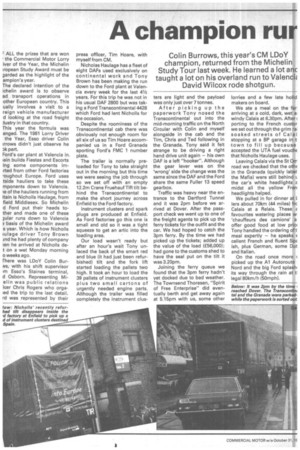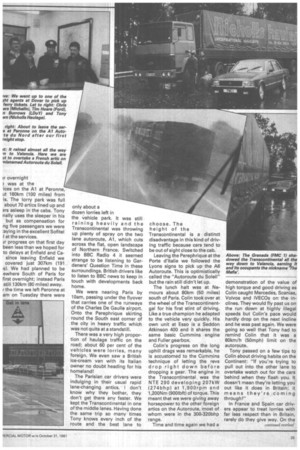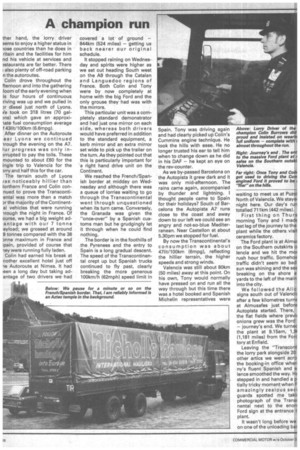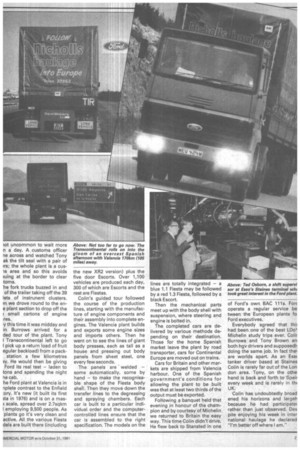A champion rui•
Page 20

Page 21

Page 22

Page 23

If you've noticed an error in this article please click here to report it so we can fix it.
Colin Burrows, this year's CM LDoY champion, returned from the Michelin Study Tour last week. He learned a lot aric taught a lot on his overland run to Valenth David Wilcox rode shotgun.
ALL the prizes that are won . the Commercial Motor Lorry iver of the .Year, the Michelin Iropean Study Award must be garded as the highlight of the ampion's year.
The declared intention of the ichelin award is to observe ad transport operations in other European country. This ually involves a visit to a reign vehicle manufacturer d looking at the road freight Justry in that country.
This year the formula was anged. The 1981 Lorry Driver the Year, Esso driver Colin irrows didn't just observe he Dk part.
Ford's car plant at Valencia in lain builds Fiestas and Escorts ing some components imfted from other Ford factories laughout Europe. Ford uses tside hauliers to take these mponents down to Valencia. le of the hauliers running from itain is Nicholls Haulage, from field Middlesex. So Michelin d Ford put their heads tother and made one of these ]ular runs down to Valencia basis of the Michelin award s year. Which is how Nicholls iulage driver Tony Brown ind he had plenty of company len he arrived at Nicholls de t on a wet Monday morning o weeks ago.
There was LDoY Colin Bur/vs, with his shift supervisor .m Esso's Staines terminal, d Osborn. Representing Mielin was public relations icer Chris Rogers who orgaed the trip to the last detail. rd was represented by their
press officer, Tim Hoare, with myself from CM.
Nicholas Haulage has a fleet of eight DAFs used exclusively on continental work and Tony Brown has been making the run down to the Ford plant at Valencia every week for the last 41/2 years. For this trip he was not in his usual DAF 2800 but was taking a Ford Transcontinental 4428 which Ford had lent Nicholls for the occasion.
Despite the roominess of the Transcontinental cab there was obviously not enough room for all six of us so Tim Hoare accompanied us in a Ford Granada sporting Ford's FMC 1number plate.
The trailer is normally preloaded for Tony to take straight out in the morning but this time we were seeing the job through so we set off with an empty 12.2m Crane Fruehauf TIR tilt behind the Transcontinental to make the short journey across Enfield to the Ford factory.
Instrument clusters and spark plugs are produced at Enfield. As Ford factories go this one is small and old so it was a tight squeeze to get an artic into the loading area.
Our load wasn't ready but after an hour's wait Tony unlaced the back of the smart red and blue (it had just been refurbished) tilt and the fork lift started loading the pallets two high. It took an hour to load the 39 pallets of instrument clusters plus two small cartons of urgently needed engine parts. Although the trailer was filled completely the instrument clus
ters are light and the payload was only just over 7 tonnes.
After picking up the paperwork Tony nosed the Transcontinental out into the mid-morning traffic on the North Circular with Colin and myself alongside in the cab and the Tim, Chris and Ted following in the Granada. Tony said it felt strange to be driving a right hand drive unit again — his own DAF is a left "hooker". Although the gear lever was on the 'wrong' side the change was the same since the DAF and the Ford share the same Fuller 13 speed gearbox.
Traffic was heavy near the entrance to the Dartford Tunnel and it was 2pm before we arrived at Dover. After the passport check we went up to one of the freight agents to pick up the ferry tickets for the outfit and the car. We had hoped to catch the 3pm ferry. By the time we had picked up the tickets; added up the value of the load (E56,000); had gone to the customs shed to have the seal put on the tilt it was 3.20pm.
Joining the ferry queue we found that the 3pm ferry hadn't yet docked due to bad weather. The Townsend Thoresen, "Spirit of Free Enterprise" did eventually berth and get away again at 5.15pm with us, some other lorries and a few late had makers on board.
We ate a meal on the fri arriving at a cold, dark, wet al windy Calais at 6.30pm. After I porting to the French custbr we set out through the grim rai soaked streets of Cali stopping at a SP garage in t :town to fill up because accepted the UTA fuel vouchE that Nicholls Haulage uses.
Leaving Calais via the St Orr road we checked that the ogle in the Granada (quickly label the Mafia) were still behind t the car's white headlights e midst all the yellow Fren headlights helped.
We pulled in for dinner at I. lers about 70km (44 miles) frc Calais at a Relais. These, E favourites watering places w 'chauffeurs des camions' , a offer good food at low prfoi Tony handled the ordering of t meal expertly — he speaks e cellent French and fluent SpE ish, plus German, some Out and Italian.
On the road once more I picked up the Al Autoroute Nord and the big Ford spla ht its way through the rain at ti legal 80km/h (50mph). 1 ir overnight ) was at the ices on the Al at Peronne. it 160km (100 miles) from is. The lorry park was full about 70 artics lined up and ars asleep in the cabs. Tony nally uses the sleeper in his but as compensation for ng five passengers we were .aying in the excellent Sofitel I at the services.
r progress on that first day been less than we hoped for to delays at Enfield and Casince leaving Enfield we covered just 307km (191 s). We had planned to be ewhere South of Paris for first overnight; instead Paris still 130km (80 miles) away. ( the time we left Peronne at am on Tuesday there were only about a dozen lorries left in the Vehicle park. It was still raining heavily and the Transcontinental was throwing up plenty of spray on the two lane autoroute, Al, which cuts across the flat, open landscape of Northern France. Switched into BBC Radio 4 it seemed strange to be listening to Gardeners' Question Time in these surroundings. British drivers like to listen to BBC news to keep in touch with developments back home.
We were nearing Paris by lOarn, passing under the flyover that carries one of the runways of the Charles De Gaulle airport. Onto the Perephrique skirting round the South east corner of the city in heavy traffic which was not quite at a standstill.
There was a very high proportion of haulage traffic on the road; about 60 per cent of the vehicles were lorries, many foreign. We even saw a British ice-cream van with its Italian owner no doubt heading for his homeland!
The Parisian car drivers were indulging in their usual rapid lane-changing antics. I don't know why they bother, they don't get there any faster. We kept the Transcontinental in one of the middle lanes. Having done the same trip so many times Tony knows every inch of the route and the best lane to choose. The height of the Transcontinental is a distinct disadvantage in this kind of driving traffic because cars tend to be out of sight close to the cab.
Leaving the Perephrique at the Porte d'Italie we followed the Lyons signs to pick up the A6 Autoroute. This is optimistically called the "Autoroute du Soleil" but the rain still didn't let up.
The lunch halt was at Nemours about 80km (50 miles) south of Paris. Colin took over at the wheel of the Transcontinentgal for his first stint of driving. Like a true champion he adapted to the vehicle very quickly. His own unit at Esso is a Seddon Atkinson 400 and it shares the same basic Cummins engine and Fuller gearbox.
Colin's progress on the long uphill drags was remarkable, he is accustomed to the Cummins technique of letting the revs drop right down before dropping a gear. The engine in the Transcontinental was the NTE 290 developing 2 07kW (2 74 bhp) at 1,9 0Orpm and 1,200Nm (900Ibft) of torque. This meant that we were giving away horsepower to the other foreign artics on the Autoroute, most of whom were in the 300-320bhp range.
Time and time again we had a demonstration of the value of high torque and good driving as Colin caught Mercedes, Scanias, Volvos and IVECOs on the inclines. They would fly past us on the run down at highly illegal speeds but Colin's pace would hardly drop on the next incline and he was past again. We were going so well that Tony had to remind Colin that it was a 80km/h (50mph) limit on the autoroute.
Tony passed on a few tips to Colin about driving habits on the Continent: "If you're trying to pull out into the other lane to overtake watch out for the cars behind when they flash you. It doesn't mean they're letting you out like it does in Britain; it means they're coming through!"
In France and Spain car drivers appear to treat lorries with far less respect than in Britain, rarely do they give way. On the ther hand, the lorry driver 3ems to enjoy a higher status in lose countries than he does in ritain and the facilities for him nd his vehicle at services and .1staurants are far better. There ; also plenty of off-road parking n the autoroutes.
Colin drove throughout the fternoon and into the gathering loom of the early evening when is four hours of continuous riving was up and we pulled in )1.. diesel just north of Lyons. Ve took on 318 litres (70 gal)(is) which gave an approxilate fuel consumption average f 43Iit/100km (6.6mpg).
After dinner on the Autoroute ear Lyons we continued irough the evening on the A7. Pur progress was only in.irrupted to pay the tolls. These mounted to about £60 for the ingle trip to Valencia for the )rry and half this for the car.
The terrain south of Lyons /as noticeably hillier than lorthern France and Colin connued to prove the Transcontiental was more than a match )r the majority of the Continental vehicles that were running 'rough the night in France. Of ourse, we had a big weight adantage with our 7 tonne ayload; we grossed at around 9 tonnes compared with the 38 pnne maximum in France and .pain, provided of course that ley were running fully laden. Colin had earned his break at nother excellent hotel just off le Autoroute at Nimes. It had leen a long day but taking adantage of two drivers we had covered a lot of ground — 844km (524 miles) — getting us back nearer our original schedule.
It stopped raining on Wednesday and spirits were higher as we set out heading South west on the A9 through the Catalan and Languedoc regions of France. Both Colin and Tony were by now completely at home with the big Ford and the only grouse they had was with the mirrors.
This particular unit was a completely standard demonstrator and had just one mirror on each side, whereas both drivers would have preferred in addition to the standard equipment, a kerb mirror and an extra mirror set wide to pick up the trailer on the turn. As they pointed out that this is particularly important for a right hand drive unit on the Continent.
We reached the French/Spanish border at midday on Wednesday and although there was a queue of lorries waiting to go through the Transcontinental went through unquestioned when its turn came. Conversely, the Granada was given the once-over" by a Spanish customs man but he grudgingly let it through when he could find nothing.
The border is in the foothills of the Pyrenees and the entry to Spain is a long gradual descent. The speed of the Transcontinental crept up but Spanish trucks continued to fly past, clearly breaking the more generous 100km/h (62mph) speed limit in Spain. Tony was driving again and had clearly picked up Colin's Cummins engine technique. He took the hills with ease. He no longer trusted his ear to tell him when to change down as he did in his DAF — he kept an eye on the rev-counter.
As we by-passed Barcelona on the Autopista it grew dark and it was only mid-afternoon. The rains came again, accompanied by thunder and lightning. I thought people came to Spain for their holidays? South of Barcelona the Autopista A7 runs close to the coast and away down to our left we could see an angry and not-so-blue Mediterranean. Near Castellon at about 5.30pm we stopped for fuel.
By now the Transcontinental's consumption was about 471it/100km (6mpg), reflecting the hillier terrain, the higher speeds and strong winds.
Valencia was still about 80km (50 miles) away at this point. On his own, Tony would normally have pressed on and run all the way through but this time there was a hotel booked and Spanish Michelin representatives were waiting to meet us at Puzol North of Valencia. We stayel night here. Our day's run totalled 711km (442 miles).
First thing on Thurs morning Tony and I ma& last leg of the journey to the plant while the others visit ceramics factory.
The Ford plant is at Almul on the Southern outskirts o lencia and we hit the mai rush hour traffic. Somehov traffic didn't seem so bad sun was shining and the see breaking on the shore a yards to the left of the main into the city.
We followed the Alic signs south out of Valenciz after a few kilometres turne at Almusafes just before Autopista started. There, the flat fields where previc onions grew was the Ford — journey's end. We turnec the plant at 9.15am, 1,91 (1,181 miles) from the Forc tory at Enfield.
Leaving the "Transcont the lorry park alongside 20 other artics we went acro the booking-in office when ny's fluent Spanish and e ience smoothed the way. HE stepped in and handled a p tially tricky moment when F amazingly zealous sec+ guards spotted me takir photograph of the Trans( nental next to the enon Ford sign at the entrance t plant.
It wasn't long before we on one of the unloading bar lot uncommon to wait more n a day. A customs officer ne across and watched Tony ak the tilt seal with a pair of :is; the whole plant is a cusis area and so this avoids )uing at the border to clear tom s.
he fork trucks buzzed in and of the trailer taking off the 39 lets of instrunent clusters. m we drove round to the ene plant section to drop off the ) small cartons of engine ires.
iy this time it was midday and in Burrows arrived for a ded tour of the plant. Tony Transcontinental left to go I pick up a return load of fruit egular backloaid) from a pack
station a few kilometres 3y. He would then be giving Ford its real test — laden to tons and spending the night he cab.
• he Ford plant at Valencia is in nplete contrast to the Enfield :ory. It's new (it built its first 5ta in 1976) and is on a masscale, spread over 2.7sqkm I employing 9,500 people. As plants go it's very clean and active. All the various Fiesta dels are built there {including
the new XR2 version) plus the five door Escorts. Over 1,100 vehicles are produced each day, 300 of which are Escorts and the rest are Fiestas.
Colin's guided tour followed the course of the production lines, starting with the manufacture of engine components and their assembly into complete engines. The Valencia plant builds and exports some engine sizes and imports others. Then he went on to see the lines of giant body presses, each as tall as a house and pressing out body panels from sheet steel, one every few. seconds.
The panels are welded — some automatically, some by hand — to make the recognisable shape of the Fiesta body shell. Then they move down the transfer lines to the degreasing and spraying chambers. Each car is built to a particular individual order and the computercontrolled lines ensure that the car is assembled to the right specification. The models on the lines are totally integrated — a blue 1.1 Fiesta may be followed by a red 1.3 Fiesta, followed by a black Escort.
Then the mechanical parts meet up with the body shell with suspension, where steering and engine is bolted in.
The completed cars are delivered by various methods depending on their destination. Those for the home Spanish market leave the plant by road transporter, cars for Continental Europe are moved out on trains.
Cars for Britain and other markets are shipped from Valencia harbour. One of the Spanish government's conditions for allowing the plant to be built was that at least two thirds of the output must be exported.
Following a banquet held that evening in honour of the champion and by courtesy of Michelin we returned to Britain the easy way. This time Colin didn't drive. He flew back to Stansted in one of Ford's own BAC 111s. For( operate a regular service be tween the European plants fo Ford executives.
Everybody agreed that thil had been one of the best LDo) Michelin study trips ever. Colir Burrows and Tony Brown arc both hgv drivers and supposedhi doing the same job. In fact the are worlds apart. As an Ess( tanker driver based at Staines Colin is rarely far out of the Lon don area. Tony, on the othe hand is back and forth to Spair every week and is rarely in th( UK.
Colin has undoubtedly broad ened his horizons and large') because he had participate( rather than just observed. Des pite enjoying his week in inter national haulage he declared "I'm better off where I am."










































